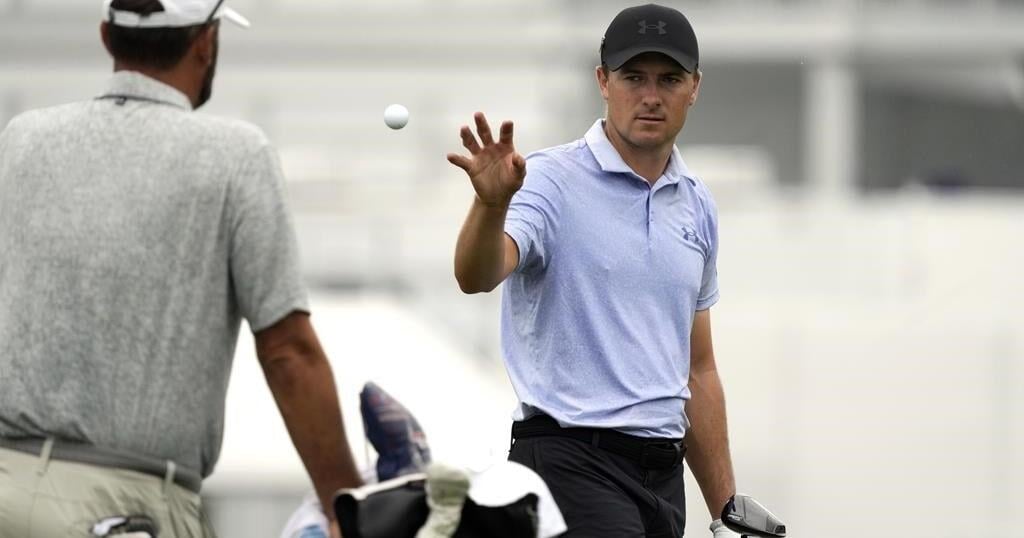MEMPHIS, Tenn. (AP) — Hideki Matsuyama lost his wallet in London and lost his caddie and coach for the start of the FedEx Cup playoffs from thieves who snatched their bag. None of that seemed to bother the Japanese star Thursday to start of the PGA Tour’s postseason.
Chris Kirk made a hole-in-one on his way to a 6-under 64 for a one-shot lead in the FedEx St. Jude Championship. Olympic gold medalist Scottie Scheffler and double major winner Xander Schauffele, the best two players in golf, were right in the mix as expected.
The surprise in some respects was Matsuyama, the Olympic bronze medalist who has had plenty of distractions since leaving Paris and still motored around the TPC Southwind on a sweltering day for a 65.
“I’ve forgotten it completely. It’s not even an issue now,” Matsuyama said through his interpreter.
He stopped over in London with caddie Shota Hayato and his swing coach, Mikihito Kuromiya. They were having dinner in town when Matsuyama said his caddie noticed the bag was no longer there. The contents included Matsuyama’s wallet, the passports of Hayato and Kuromiya. Matsuyama had left his passport — and his bronze medal — in his hotel room.
“It was an unfortunate situation,” Matsuyama said. “Luckily, I only lost my wallet, but Shota, my caddie, and the coach, lost their passports, and we’re trying hard now to get their visas back in line. And, hopefully, we can join as a team as soon as possible.”
In the meantime, he lined up Taiga Tabuchi, who had been caddying on the Japan LPGA recently and had worked with Ryo Hisatsune on the PGA Tour earlier this year.
New caddie, same old Hideki. The former Masters champion has been building momentum over the last month. After hitting into the water and taking bogey on the par-5 third hole, he answered with plenty of birdies — four in a five-hole stretch on the back nine, for a 65.
“My job is the same. It’s just play golf,” Matsuyama said. “I talk to my coach every night on the phone. I’ve got a great caddie — Taiga did a great job today. So we’ll just see how it goes.”
Hayato hopes to be back on the bag at the Tour Championship. Matsuyama is No. 8 in the FedEx Cup and assured of being there.
That isn’t the case for Kirk, who is No. 28 in the standings. The top 50 after this week advance to the BMW Championship outside Denver, and then the top 30 from there go to Atlanta.
Kirk had taken the early lead with a birdie on the 12th when he pulled 6-iron — a perfect club considering a heat index that topped 100 degrees (38 Celsius) that made the ball go a little bit farther. It landed in front of the pin and rolled in like a putt for an ace.
“I was looking a little further left than that with water on the right, but as soon as I hit it, I hit it just how I wanted to,” Kirk said. “Looked up, saw it started a touch right but was drawing right back to it. Yeah, nice bonus.”
He left one opportunity out there by needing two chips to reach the green on the par-5 16th, the easiest hole at the TPC Southwind, and a drive into a bunker on the 18th kept him from reaching the green and led to his only bogey of the round.
Taylor Pendrith of Canada and Matthieu Pavon of France, both first-time winners on the PGA Tour this year, joined Matsuyama at 65.
The large group at 66 included Scheffler and Schauffele, who have combined for three of the four majors, eight PGA Tour titles and just over $44 million in earnings this year.
Schauffele started with three straight birdies, cooled slightly and picked up a late birdie on the 16th for a bogey-free round. Scheffler had four birdies through six holes, his lone bogey coming on a poor greenside bunker shot on the 12th.
Friends in the first place, they grew a little closer through three days of practice rounds and some money games at Le Golf National leading to the Olympics. Schauffele shared the 54-hole lead at the Olympics. Scheffler closed with a 62 and won the gold.
“It’s fun competing with your friends, but we want to beat up on each other,” Scheffler said. “So it’s a lot of fun playing with the best players and competing.”
Justin Rose (No. 55) and Ben Griffin (No. 56) got off to ideal starts in their bid to get into the top 50 and keep their seasons going, both part of the group at 66.
Jordan Spieth is No. 63 and opened with a 62, making two bogeys from the fairway on the back nine that slowed his progress.
___
AP golf:

























